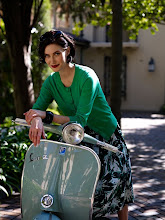Speaking of Language in Art
There is a sequence of dialogue in a film by Marc Ottiker, Halbe Miete (2002), addressing art legibility and audience comprehension. The protagonist, Peter, is assisting a writer in assembling his storyboard. The writer explains:
“The way I see it, the people sitting in front of the TV don’t feel challenged enough, which upsets them. Some feel like they’re being fucked with. 70% of the audience is not being challenged intellectually, but instead they focus on the other 30%.”
The writer believes a more complex structure to a work of art could more often than not be established. In my previous post I intimated that in painting I believe this “complex structure” consists of a work built entirely of images. I have found it an insult to my intelligence as a viewer that the artist would feel the need to use a much more commonly understood language, the written word, to expose meaning. Reflecting on it now I see another perspective, I may have acted some zealous puritan for imagery unnecessarily.
Contemplating the medium of film seems to enlighten the other side of the argument. Film gives us the perfect cohesion of aural and visual language in motion. Perhaps it’s a viable thing in painting also, this dual presentation of language. Perhaps it’s a beautiful junction: text and image. Essentially the two are fastened together so seamlessly that on serious contemplation it’s hard to actually separate them at all. Eco devotes an entire chapter to this very discussion entitled: The Perfect Language of Images in his bookThe Search for the Perfect Language. A contemplation for another post. For now, let’s keep it simple.
There is a depth to the written word equal to that of imagery: one that, like imagery, is not understood by all. We see this in the literary arts:
Stately, plump Buck Mulligan came from the stairhead, bearing a bowl of lather on which a mirror and a razor lay crossed. A yellow dressing gown, ungirdled, was sustained behind him by the mild morning air. He held the bowl aloft and intoned:
-Introibo ad altare Dei.
Excerpt from Ulysses, James Joyce
Both word and image have a duality to them, both exist as multiple things at once: an actual object, a symbol of meaning, an allusion to a history of meaning evoked throughout the history of art and literature. Using word and image together may well serve to amplify meaning or allow the subtle meaning present in one, to play off of meaning in the other: a dynamic unveiling.
And so I have come full circle. I see the merits for the use of text in conjunction with image in painting and drawing, beyond my instinctive reaction against it. I see the beauty of it. I wont judge it so harshly next I see it, and I may be more inclined to use it myself.


5 Comments:
So where do you stand on Calligraphy - the art of writing?
Seeing as you seem to want to separate word and image...
Some graffiti is both, and very accomplished. This is then an taste/ aesthetic hurdle.
The Practise of fusing word and image dates back to the Celts, perhaps even heiroglyphs.
Ah! The designer in you would definitely enjoy the chapter on imagery in Umberto Eco's book 'The Search for the Perfect Language'. Definitely.
It traces the relationship between imagery and text from the hieroglyphic script of the Egyptian alphabet, through the Renaissance, Chinese script, right down to current international symbols.
Calligraphy. In concept, I approve ;)
The idea of the written word: I've been fascinated by the appearance of script as long as my memory serves me... I like the stylized and decorative writing of the illuminated manuscripts of the middle ages (eg 'The Book of Hours), and the way the futurists were consciously influenced by this. They used configurations of type which related to images in the poetry they produced. The topographic experimentation in their time influenced modern page layouts.'The Treatise on Total Indecency' written in 1920 by Zdanevich and Terentyev did revolutionary things like print sentences in part Cyrilic and part Latin typefaces, print parts of words in capital letters to illustrate internal or alternative word meanings. Tres cool. I'm sure you know more about this stuff than I do.
I love all this stuff, the development of fonts over the last 100 years or so. The fact that different schools of thought and ideals are tied to different typefaces. I do see it as a separate strain to fine art, more as design, although I know they crossover in terms of influences,the futurists by the cubists for example. I like a lot of graffiti art for this connection to the history of script, as long as the artist is aware of what they are referencing.
I'm not so familiar with Celtic symbols, will have to look them up.. hmm, which also gets me thinking of Maori designs and their origins..
Nice.
Such a considered response.
The Book of Kells is what you should check.
Yes I have looked at Umberto Eco, but not in depth.
Off to the library.
Why the comparison of film and image or film and painting? Just because film is a perfect cohesion of aural and visual language in motion text in painting doesn't need to be a perfect cohesion... I do not see a relationship there. It is a valid consideration but I say that the best way a message is expressed through art is when it is pure. What do you need for a perfect play, for a great ballet piece etc. It's the focus on the main medium of an individual piece of art and not a mix of them.
Calligraphy is beautiful writing but it is writing.
And in an update:
Lindeman's text-based ''paintings'' won the $20,000 Sulman Prize and the Fisher's Ghost Art Award last year.
Read more: http://www.smh.com.au/entertainment/art-and-design/wanted-man-37-seeks-ads-to-transform-into-artworks-20110628-1gp0m.html#ixzz1QiLK2ZlX
Post a Comment
Subscribe to Post Comments [Atom]
<< Home